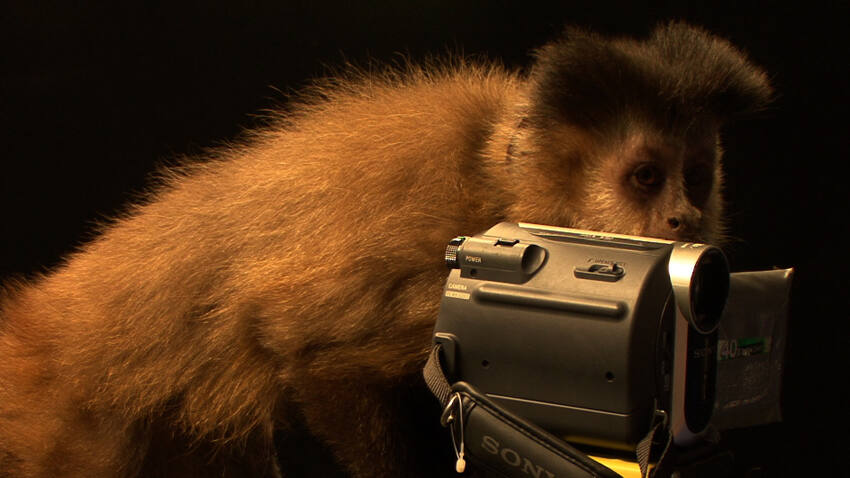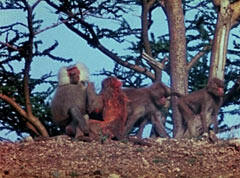Übergordnete Werke und Veranstaltungen
The Long Night of the Apes
Media
Primates in film were an early mirror of science. In 1925, the psychologist Robert Yerkes, one of the pioneers of primatology, published his experiences with two chimps purchased from a seaman in Boston under the title Almost Human. According to Yerkes, the organisation of wild monkey packs was dominated by the motor-active male that secures the terrain for the passive female. A gorilla by the name of King Kong embodied this non-civilized, original, masculine force in the box office hit from 1933. A year before King Kong (the German title translates King Kong and the White Woman), a study was published on the behaviour of jungle gorillas that ended with the researcher shooting a silverback as it ran towards his wife. King Kong relates therefore not only a story sprung from Hollywood fantasy. The film enriches its material with images drawn from science.
That the film Planet of the Apes from 1968 could be seen in the context of the problem of human society was tied to the fact that scientists were confronting apes with increasingly concrete questions about American culture. Harry F. Harlow, a leading psychological consultant for the US army performed deprivation experiments on rhesus monkeys looking for a primate model for battle psychosis and depression, which had left not even the smallest village untouched in the wake of WWII and Korea.
At about the same time, the physical anthropologist Sherwood Washburn from the University of Chicago began holding lectures on early hominoid evolution. Sherwood was a researcher trained in classical morphological methods of primate anatomy. As a decided opponent of race classifications and hierarchies, he introduced the concept of population into anthropology. He justified his funding requests with the importance of the studies for human psychology and psychiatry. The studies of Indian langurs and African baboons often lead to contrary results and the comparison to humans often had to be abandoned.
Washburn and his students regularly published popular versions of their work, cooperated on curricula and made educational films. In the late sixties and early seventies there was practically no social discourse without comparisons to non-human primates and arguments from studies of them, whether pertaining to war, urban criminality, abandoned mothers, strikes, divorce, prostitution, the surveillance of black gang leaders by telemetry or equal rights for women. The National Geographic Society was also responsible for enabling the ape metaphor to become so charged with meaning in the 1968 era. National Geographic Magazine published the first copiously illustrated report of a young English woman, who had gone to the jungle with only her mother and a cook for company to study chimps. Jane Goodall was neither kidnapped nor killed in the process and thus inverted the traditional idea of femininity.
1968 was also the year in which the primatologist Hans Kummer screened his documentary Anpassung eines Anubis-Weibchens an das Haremssystem der Mantelpaviane (A Female Anubis Adapting to the Harem Regime of the Hamadryas Baboon). The film shows an experiment carried out on a group of baboons in the wild in Ethiopia and was intended as an instructional film for universities. This work, a kind of importing of the wild into civilisation, was continued by Luis Nieto in his film Capucine from 2009. The film documents the work with various monkeys in a Japanese primate lab. The monkeys live in spacious enclosures and have excellent computer and film camera skills. From this starting point only a small step is required toward the first film made by a monkey.


